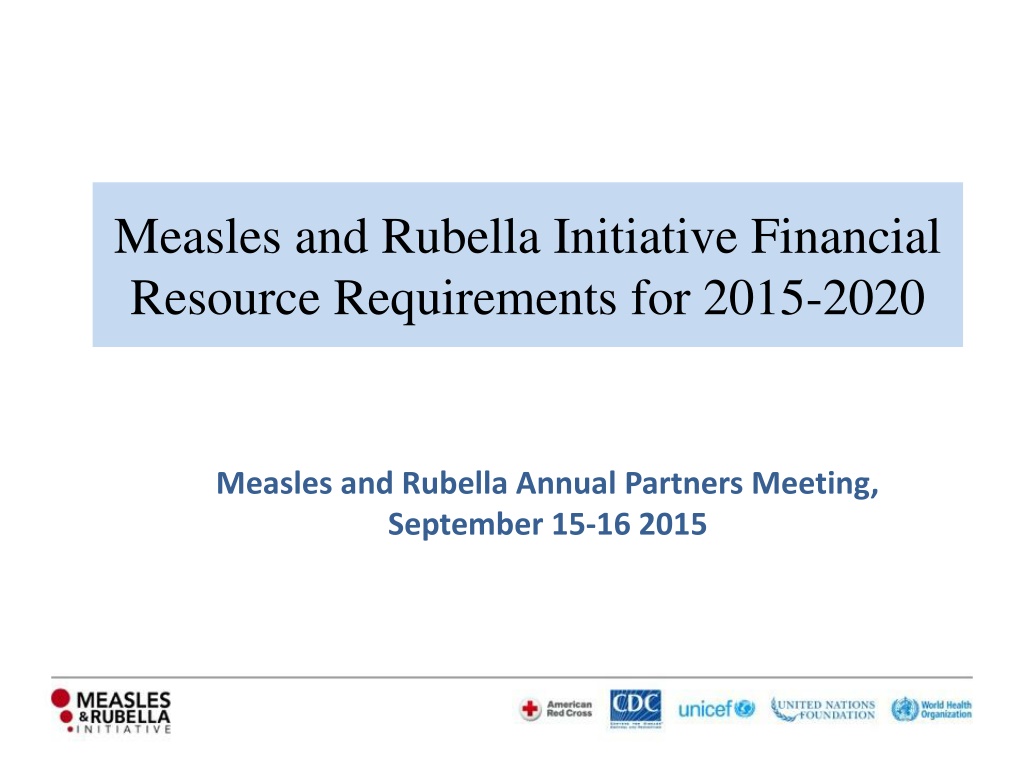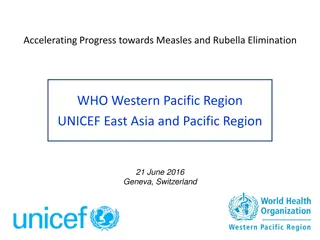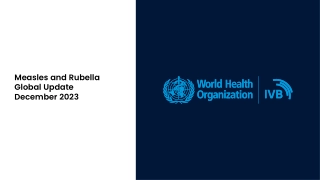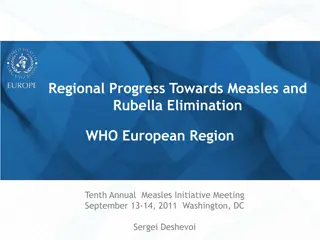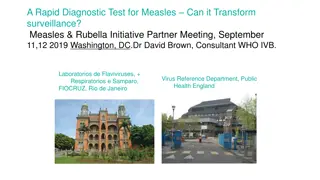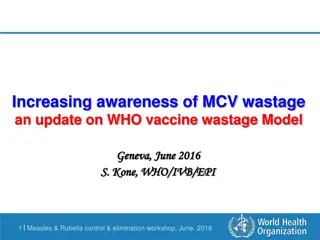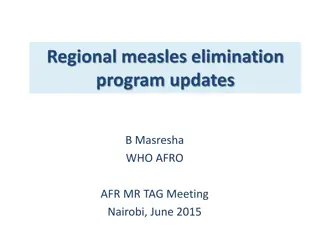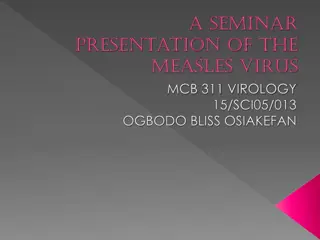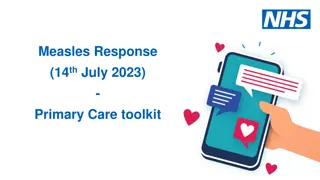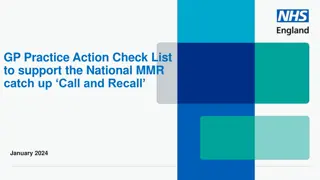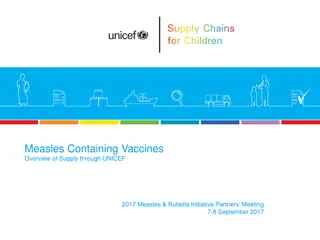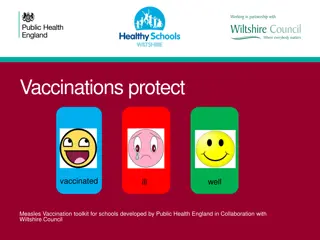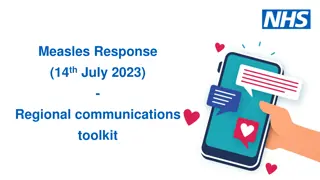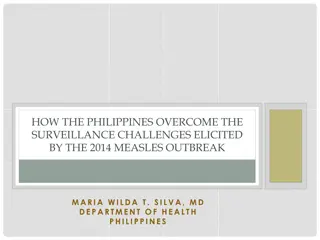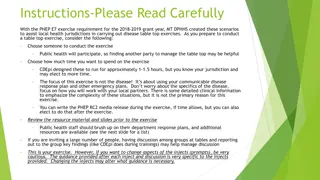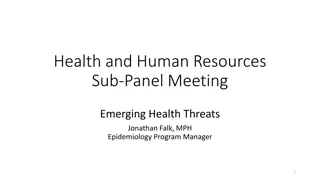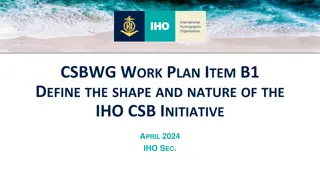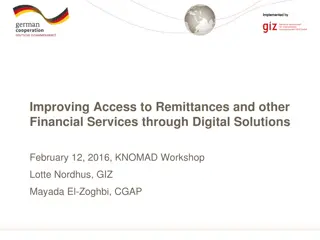Measles and Rubella Initiative Financial Resource Overview
The Measles and Rubella Initiative's Financial Resource Requirements for 2015-2020 were developed to support the Global Measles & Rubella Strategic Plan. The estimated budget is $2.6 billion for 2015-2020, focusing on controlling measles, rubella, and CRS in 77 countries. The costs are categorized into seven major areas, including follow-up campaigns, surveillance, outbreak response, communication, research, and core functions. Donors have contributed significantly, with GAVI committing to support catch-up campaigns and routine second dose administration.
Download Presentation

Please find below an Image/Link to download the presentation.
The content on the website is provided AS IS for your information and personal use only. It may not be sold, licensed, or shared on other websites without obtaining consent from the author. Download presentation by click this link. If you encounter any issues during the download, it is possible that the publisher has removed the file from their server.
E N D
Presentation Transcript
Measles and Rubella Initiative Financial Resource Requirements for 2015-2020 Measles and Rubella Annual Partners Meeting, September 15-16 2015
Background The MRI FRR is developed by the M&RI FRR/RMAWG Country population data is drawn from UNDP estimates Vaccine type and timing of SIAs is from countries cMYPs. Vaccine and devices costs are projected from UNICEF SD data Operational cost data is generated from >10 yrs of M&RI experience in 88 countries. FRRs are reviewed and updated biannually to reflect changes. Data for this FRR is as of June 2015
Donors to Measles and Rubella Initiative, 2001 - 2014 Japan 1% UNICEF 11% UNF 7% Lions 1% DFID 5% UNF ARC 14% ARC Norway 2% CDC GAVI Merck <1% CIDA IFFIm LDS 1% Gates LDS Merck Gates 3% Norway DFID Lions IFFIm 12% UNICEF Japan CDC 32% GAVI 7% CIDA 4%
GAVIS COMMITMENT TO MEASLES and Rubella Measles-Rubella Catch up campaigns for children aged 9 months to 14 years Measles follow up campaigns 6 high risk countries (Afghanistan, Chad, DRC, Ethiopia, Nigeria, Pakistan) for children aged 9 59 months Outbreak response fund to Measles Rubella Initiative (US$ 55m through to 2017) Routine Measles second dose for (duration of 5 years)
Overview of the 2015-2020 FRRs The 2015-2020 FRRs are the projected cost estimates necessary to support the Global Measles & Rubella Strategic Plan 2012-2020. As of Jun 2015 data, M&RI estimates FRRs budget of $2.6 billion for the period 2015-2020 to further advance measles, rubella, and CRS control in the 77 focus countries. Annual costs peak at $662 million in 2016 and declining to $276 million in 2020.
These FRRs have 7 major cost categories Measles/Measles Rubella (MR) Follow Up SIAs (23%) MR Catch-up campaigns (57%) Surveillance and Laboratory (4%) Outbreak Preparedness and Response (3%) Communication (0.26%) Research and Development (0.39%) and Core Functions: modest RI support & Human resources (10%).
Summary of resource requirements by major category of activity, 2015-2020
Budget by Major Category and sub categories, 2015-2020 (US$) $700,000,000 $600,000,000 $500,000,000 $400,000,000 $300,000,000 $200,000,000 $100,000,000 $0 2015 2016 2017 2018 2019 2020 M & MR SIAs MR catch-up Campaigns Effective Surveillance Outbreak Preparedness & Response Communication Research & Development Core Functions
Why Measles and Rubella and Why these huge sums? Measles and Rubella exert tremendous socio-economic toll: Africa: it has been documented that medical costs can equal one month of family income Re-infected countries: maintaining elimination means US$5,000 to 50,000 per outbreak case on treatment and outbreak investigation cost Rubella: lifetime costs for chronic care per case of Congenital Rubella Syndrome (CRS) range between $11,300 for low income countries to $934,000 for high income countries. Maintaining high control is very costly: estimated at >$8 billion per year, meaning that time limited global elimination has enormous returns. 9
Pledged and Expected Contributions Pledged/ Expected 2015 2016 2017 2018 2019 2020 Total Gavi National governments 155,159,762 107,785,428 165,225,718 213,746,225 97,100,322 60,982,545 800,000,000 141,134,332 502,392,371 255,102,639 102,720,238 50,385,019 51,569,933 1,103,304,532 M&RI 62,192,500 47,500,000 47,500,000 36,500,000 36,500,000 36,500,000 266,692,500 Carryover Total pledged/ contributions 10,829,549 10,829,549 369,316,143 657,677,799 467,828,357 352,966,463 183,985,341 149,052,478 2,180,826,581 Anticipated Funding gaps 47,512,427 4,897,936 47,112,364 122,678,162 81,887,834 127,335,095 431,423,818
Expected Contributions and Funding Gap, 2015- 2020 431 million (17%) 1.1 billion (42%) 266 million (10%) 800 million (31%) National Governments Gavi M&RI traditional partners Funding gap
Challenges and way forward Challenge in securing timely national government funding and the promotion of sustainability through domestic resource allocation Need to further streamline information flow from countries to regions/ global levels Frequent changes in the SIAs schedule & target population Need for Prog. innovations, further improve quality of immunization activities and accountability Gavi new measles and rubella strategy Costing of measles elimination/eradication and investment studies
Anne Ray Charitable Trust 209-OFF-Vodafone_Square
